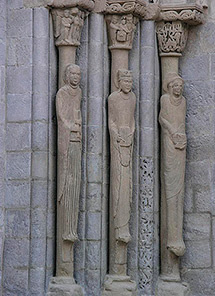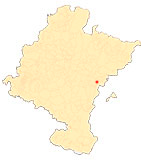The Gateway of Santa María de Sangüesa
By Clara Fernández-Ladreda Aguadé
|
THE ARTISTS. THE WORKSHOP OF SAN JUAN DE LA PEÑA AND THE WORKSHOP OF SCHEMATIC FIGURES |
|
The artists. Leodegario and his workshop
Three successive workshops were involved in this cover. The first would be the one directed by Leodegarius, who attested his participation through the registration that appears in the book of the statue-column of the Virgin: Leodegarius me fecit - "Leodegarius made me"-. The lower part is due to him: all the sculptures of the door and the buttresses, and most of those of the spandrels. The best pieces should be attributed to the master, that is, the statues-columns and, possibly, a part of the Infancy cycle - Annunciation-Coronation, St. Joseph's dream and Visitation-, while the rest should be attributed to his workshop, since a decrease in quality can be seen. The participation of this workshop is also detected in some capitals of the interior, two in the main chapel that remain in their original location and two in the central nave that have been reused, as shown by the adaptations they have undergone.
In the human figures all these works are characterized by employment of a very characteristic typology of heads and by the reiteration in the clothes of a series of elements: zig-zag borders with the interior filled with diagonal lines, curved and counter-curved borders accompanied by multiple folds of the same shape parallel to each other, closed cloaks with the lower part arranged in an elliptical fall covered with concentric folds. The animals also have common features, both in the heads and in the manes, claws and wings.
The part of the doorway in Sangües due to Leodegario and his followers shows the influence of the central western doorway of the abbey of Saint-Denis (1135-1140) and the western doorways of Chartes (1145-1155), heads of the series of the first French and European Gothic doorways, which is where its relevance lies, as this makes it one of the first Hispanic doorways and the first in Navarre that sample such an influence despite its classification within the Late Romanesque style. This influence is manifested both in compositional aspects -employment of the pointed arch, presence of statues-columns, longitudinal disposition of the figures of the archivolts and others - and stylistic - especially in the statues columns with their rigidity and slender canon, and the characteristic treatment of their clothing - and even iconographic - fully developed Last Judgment, parable of the foolish and wise virgins and angelic bosom, possibly taken from the Parisian abbey -. All this seems to indicate that Leodegario knew the work of these French stonemasons and that he came from the neighboring country, a hypothesis reinforced by the name, which is totally foreign to the Hispanic world.
contact Leodegario and his collaborators also worked outside Navarre, and can be attributed the tomb of the Infanta Doña Blanca (1156-1158) -daughter of García Ramírez of Navarre and wife of Sancho III of Castile- in Santa María la Real de Nájera (La Rioja), and the arches of the interior of the apse of the church of San Martín de Uncastillo in Zaragoza (1170s), both works that offer many points of contact with the portal of Sangüesina, both iconographically and formally. In Navarra this workshop has been related to a modillion and other pieces from the church of Echano.












